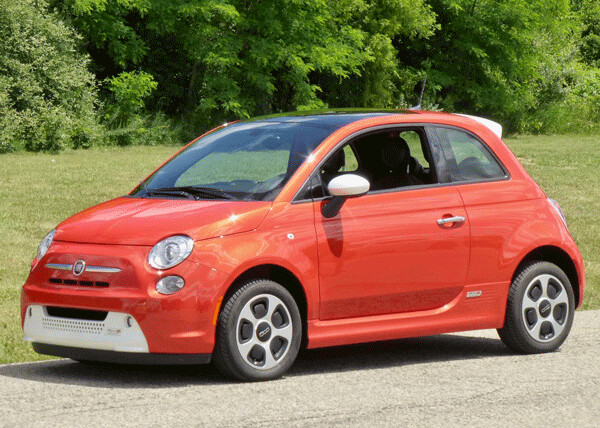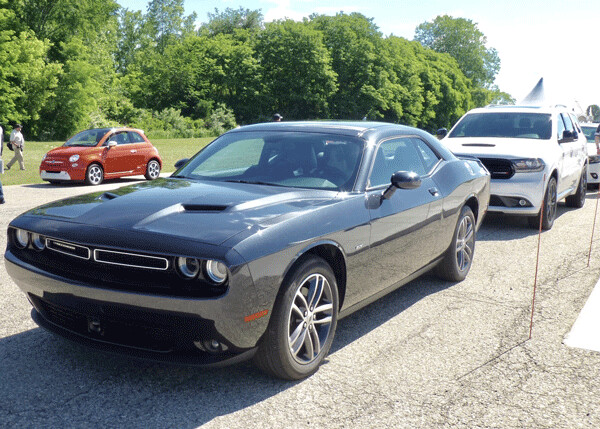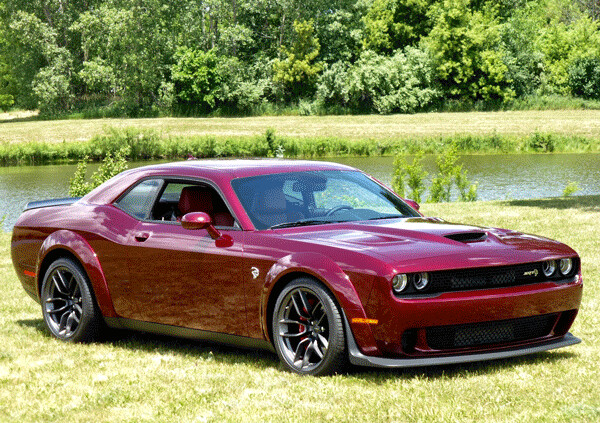From Hellcat to Demon to Widebody...and tiny 500e

Year by year, we’re getting accustomed to calling everything from Dodge and Chrysler by their proper name — FCA, for Fiat Chrysler Automobiles. Naturally, that includes all things Fiat, plus Jeep and Ram as well.
So this year, when FCA folks called to invite me to make a trip to the Auburn Hills, Mich., test track facilities for FCA, I knew exactly who was calling and why I’d better accept. It was easy to identify the company this year, because my favorite vehicles to drive at the What’s New for 2018 visit to the Auburn Hills, Mich., proving grounds ranged from both ends of the spectrum — from Hellcats and SRT screamers to the smallest and most unassuming tiny Fiat 500. And don’t ask me to choose just one.
While the array of racy coupes and sedans and SUVs were lined up for us to drive, across the way there was a row of Fiats lined up nose to tail. There was the 500, the Abarth, the 500L and the 500X, and then there was the most stunning paint job in the county, adorning one cute little Fiat 500. The paint was Spitfire Orange Clearcoat, and the car was the 500e.

That’s right, pure electric. I drove it a couple of laps on the oval and then on the serpentine switchbacks of the interior road-test course, and the torque-happy 500e was eye-popping. It was quick taking off, which I anticipated, because electric motors produce maximum torque at 0 RPMs. But the 500 was light and agile around the twisty parts, with great power to accelerate out of each switchback.
In the 500e, the battery pack is made by Samsung, and the computerized coordination is supplied by Bosch. Its range is 87 miles between recharges according to the EPA, but several Fiat folks told me that judicious use of the regenerative braking on the 111 horsepower Fiat 500e can easily take you past 100 miles.
Best part of it all is that when you hook up the 6.6 killowatt on-board charging module to a Level 2 energy source (220 volts), you can recharge the thing in less than four hours.
Fiat says its intention was to engineer the 500e to feel just like a normal 500, but it doesn’t. It feels much better!Elsewhere, there was a lot to drive, and some of it is protected by embargo from being written about yet. I will say that anybody who drives the new Challenger GT with its all-wheel-drive and V6 powertrain might be astonished to find out how well it handles. At its introduction in Maine, we learned how it works in snow, but at Auburn Hills, I got a chance to compare it to other performers on the tight track. I made an off-hand comment to a Dodge engineer that it might be the best-handling car Dodge has ever built.


The Durango SUV gets SRT treatment, which is stunning, and the often-overlooked Journey, which seems unsure whether to be a downsized SUV or a mini-minivan, also gets SRT trim and some punch. I was impressed that the Journey is the best-selling vehicle in the Dodge stable.
But all of that still didn’t get us past the highlight of the day for every attendee. We might have thought performance was a thing of the past, but instead, if someone intends to make all kinds of fun American driving cars, it might as well be Dodge.
Every auto company in the world is now locked into tight competition for small cars, compact cars, midsize and large cars, but mostly trucks, from large pickups to SUVs of all sizes, with a current focus on compact crossovers. Nobody says much about performance, but FCA does.
In fact, maybe it’s because Fiat owns Ferrari and Alfa Romeo as well as Dodge and Chrysler, that FCA has decided to let Jeep do its thing, let Ram trucks do their thing, let Chrysler have large sedans and the new minivan, and turn over all performance-oriented creations to Dodge.
When you’re part of SRT — for Street Racing Technology — you jump into action. No waiting around for second thoughts.
And Dodge was arguably the star of the show among the 2018 models waiting to hit the showrooms later this summer. It’s fascinating to note what Dodge is up to and why, in this era of small engines, high-mileage, and green environmental stature, Dodge should go the other way, in a big way.

Dodge dazzled us all with the introduction of the Hellcat two years ago. It loaded its 6.2-liter Hemi V8 into both the Challenger coupe and the Charger sedan, slapped all sorts of high-performance goodies to them, and topped it all off with a supercharger to blast fresh air into the intakes.
The result was an absolute screamer, appropriately named “Hellcat,” for all the go-fast elements. The Challenger SRT Hellcat and the Charger SRT Hellcat were the most powerful and fastest cars ever built, and the engine made Ward’s annual list of the top 10 Best Engines for 2015, well-deserved for an engine that creates 707 horsepower and 650 foot-pounds of torque, in a car equipped with all sorts of self-timing devices and drag-race clutch-release gizmos.
So what could Dodge add this year that would grab us all? How about the Demon, a monster among monsters? Far as I know, nobody complained about the Hellcat being down on power, but the Dodge boys, or, more specifically, the SRT gang, found more power.

But they redid the 6.2 Hemi with different internal plumbing and a different supercharger, and instead of a mere 707 horses and 650 foot-pounds of torque, the new model delivered 840 horsepower and 770 foot-pounds. Dodge claims the Demon will cover 0-60 speeds in either 2.3 or 2.1 seconds. We didn’t get to drive the Demon, we could just look at it casually parked under a shade tree at the test facility, reminding me of Ferdinand, the old bull in the kid’s book.
Now that the Demon has been introduced and we know it exists, it seems worth our sympathy that the Hellcat is now rendered to the background. Or is it?
Nope, a surprise for 2018 is the new Challenger SRT Hellcat Widebody! The Demon sits wider than the everyday Challenger, so Dodge did some testing and found that they could widen the Hellcat by 3.5 inches and it not only would look lower and more imposing from the front, but it would handle and corner significantly better.
Wearing Pirelli 20-inch P-Zero tires on 11-inches-wide split-five aluminum wheels, the SRT Hellcat Widebody can shave approximately 2 seconds per lap off the standard Hellcat’s lap times. That is about 13 car-lengths, or enough to cause you to park your trailing Hellcat and watch from the stands.
That means instead of paying an absurd amount of money for the Demon, you can chop a little bit off that and pay $71,495 and get the Demon-wide Challenger Hellcat Widebody with improved handling and that low, sinister look.
